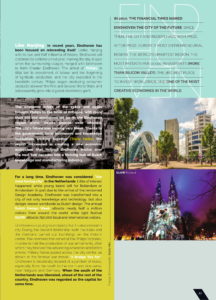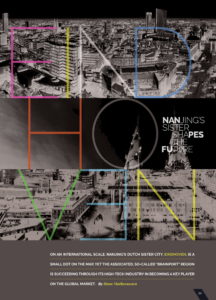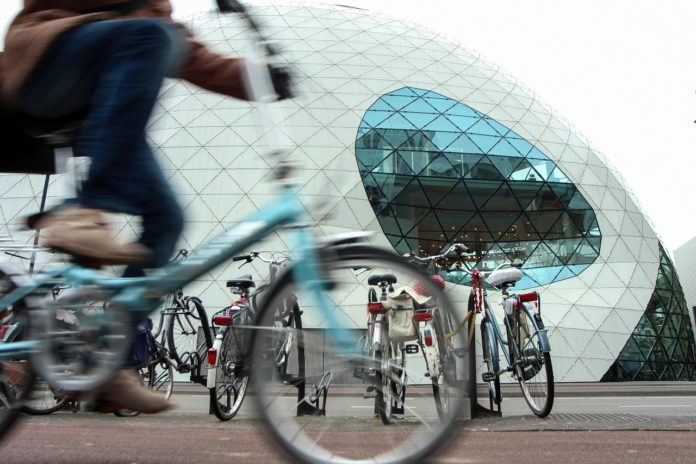The Nanjinger, an English webzine, features Eindhoven in their recent write-ups. The Nanjinger calls Eindhoven a world village….to find out why? Here is the article below:
On an international scale, Nanjing’s Dutch sister city, Eindhoven, is a small dot on the map, yet the associated, so-called “Brainport” region is succeeding through its high-tech industry in becoming a key player on the global market.
In 2010, the Financial Times named Eindhoven the city of the future. Since then, the city and region have won prize after prize: Europe’s most entrepreneurial region, the world’s smartest region; the most patents per 10,000 inhabitants (more than Silicon Valley), the third best place to invest globally and one of the most creative economies in the world.
Like Nanjing, in recent years, Eindhoven has been focused on reinventing itself. Unlike Nanjing with its two and half millennia of history, Eindhoven will celebrate its centenary next year, marking the day in 1920 when five surrounding villages merged with Eindhoven to form Greater Eindhoven. The arrival of Philips in 1891 led to the recruitment of labour and the beginning of lightbulb production, and the city exploded in the twentieth century. Philips began producing consumer products between the First and Second World Wars, and subsequently grew into a global electronics giant.

The economic crises of the 1980s and 1990s brought Philips to the brink of collapse, with more than 100,000 employees let go. In the Eindhoven region alone, 30,000 people were affected. The city’s future was looking very bleak.Thanks to the government, local businesses and knowledge institutions working together (Triple Helix), the region succeeded in creating a new economic ecosystem that helped Eindhoven evolve over the next two decades into a thriving hub of Dutch knowledge and manufacturing industry.
For a long time, Eindhoven was considered “the most boring city” in the Netherlands. Little of interest happened, while young talent left for Rotterdam or Amsterdam. In part due to the arrival of the renowned Design Academy, Eindhoven was transformed into a city of not only knowledge and technology, but also design; known worldwide as Dutch design. The annual Dutch Design Week attracts nearly half a million visitors from around the world, while light festival GLOW attracts 750,000 local and international visitors.
Eindhoven is a young municipality, but it is also a modern city. During the Second World War, both the Allies and the Germans carried out bombings on the historic centre. The bombers first aimed at the Philips factories, in order to halt the production of war armaments, after which they blocked the advancing American and British armies. Military forces pulled across the city centre, as shown in the famous war movie “A Bridge Too Far”. Eindhoven is historically located at a junction of roads, especially from the south to the north and vice versa, near Belgium and Germany. When the south of the Netherlands was liberated, ahead of the rest of the country, Eindhoven was regarded as the capital for some time.
Since the war, Eindhoven has built a new
future and put its stamp on the world. The top hat US President John F. Kennedy wore at his inauguration? Made in Eindhoven. George Harrison’s first guitar? Made in Eindhoven. The first TV broadcast in the Netherlands was transmitted from Eindhoven. The first Dutch-language film was recorded in Eindhoven. The compact audio cassette was invented in Eindhoven by Philips, as was the later compact disc that revived the music industry worldwide. Through record company Phonogram (later Polygram), Philips is acquainted with stars such as The RollingStones, Abba, Elton John, and U2.
Still, with music, Eindhoven is home to the Muziekgebouw, a first-rate concert hall with acoustics among the top 5 in the world. The Van Abbemuseum is a mecca for modern art lovers, while the Parktheater hosts stunning theater performances, plays, and cabaret shows. Urban culture can be found in Strijp-S, a former complex of Philips factories that have been successfully transformed into a brand-new district for residents and professionals, while the Brainport region is also a culinary hotspot; after Amsterdam, Eindhoven has the most Michelin-starred restaurants in the country.
Next to Amsterdam’s financial center and the port city of Rotterdam, Eindhoven is the third largest metropolitan region in the Netherlands. For a long time, Eindhoven was a typical low-rise city, broad and spacious with lots of greenery, but now, the city is booming, and on the cusp of a leap in scale. Around 20 skyscrapers are scheduled to be constructed over the coming years, a big number for a city that previously built five in the last 20 years.
 Dubbed a “world village”, people from all over the world are coming to the region to work at one of the many high-tech companies based therein. In 2000, there were 324 Indians living in Eindhoven. Last year, that number had risen to 3,556, and they have since even set up their second cricket team, to feel right at home. Many students have also found their way to the city; The Eindhoven University of Technology has around 12,000 students, sixteen percent of whom come from abroad. TU/e (Eindhoven University of Technology) students span 90 nationalities, the top 3 of which are Indian, Chinese and Romanian.
Dubbed a “world village”, people from all over the world are coming to the region to work at one of the many high-tech companies based therein. In 2000, there were 324 Indians living in Eindhoven. Last year, that number had risen to 3,556, and they have since even set up their second cricket team, to feel right at home. Many students have also found their way to the city; The Eindhoven University of Technology has around 12,000 students, sixteen percent of whom come from abroad. TU/e (Eindhoven University of Technology) students span 90 nationalities, the top 3 of which are Indian, Chinese and Romanian.
So just what is it about this mix of towering, international ambition and the serenity of village life that makes the city an economic success? Eindhoven inhabitants are naturally friendly and keen on enjoying life, but their work ethic is solid. That’s how it worked back in the days when farmers helped each other survive on the bare sandy soils, this attitude of collaboration persists to this day. Entrepreneurs have been coming to Eindhoven for a better future for a hundred years now, and they are welcomed with open arms by the locals, people who are also ambitious and push each other to make progress, feeding a dynamic that ensures success and employment.

“The city that is Shaping the Future” was the title of the book former Eindhoven Mayor Rob van Gijzel left as a gift to the city on his departure in 2016. Over the past century, Eindhoven has become synonymous with great feats, each exceptional in their own right, but as a whole, forming an almost kaleidoscopic image of infectious aspiration.
Writer: Hans Matheeuwsen, Chief Director, Frits Magazine.
Photos: Eindhoven365 & Eddie Mol
Translation: Nicola Wood and Irene Martens











